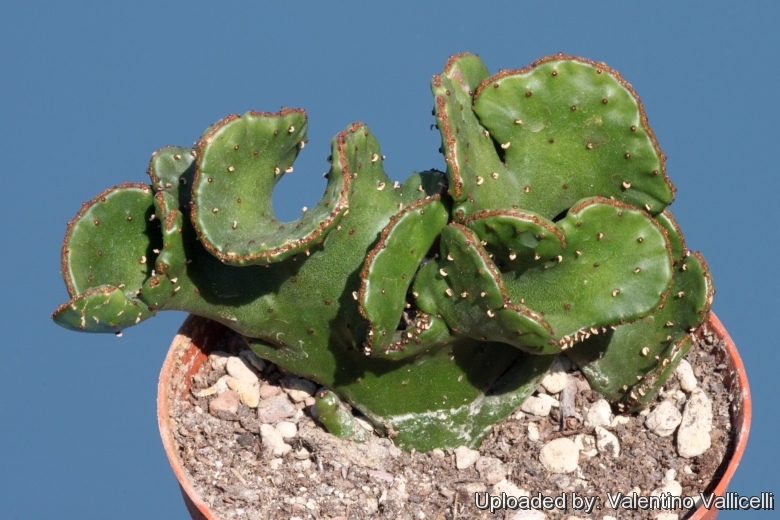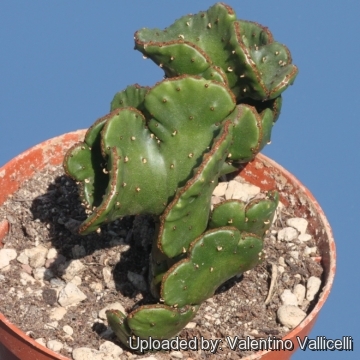Accepted Scientific Name: Euphorbia alluaudii Drake
Bull. Mus. Hist. Nat. (Paris) 9: 43 1903

Euphorbia alluaudii f. criatata Photo by: Valentino Vallicelli
Origin and Habitat: Garden origin (Nursery produced cultivar). The original natural habitat of this species are the warmer areas of South-west Madagascar, extending towards the central high-plateau: Androy; Andrahomana; Ambovombe (Tsimananada).
Synonyms:
See all synonyms of Euphorbia alluaudii
Description: Euphorbia alluaudiiSN|27008]]SN|27008]] (Cat Tails Euphorbia) is a dioecious (exceptionnaly monoecious) succulent shrub or small tree made up of clusters of cylindrical, jointed, spineless branches. Most of its branches rise erectly from the base and then arch outwards to form a mass as wide as tall. It can ultimately reach to 4(-6) metres though in containers it more commonly grows to a modest 1.2-1.8 metres tall.
crested dorm: The beautiful crested form (Euphorbia alluaudiiSN|27008]]SN|27008]] f. criatata) is rare in collection and highly priced for its sculptural shape and glossy green epidermis. The crested form can also get very big making a spectacular specimen.
Stems: Fan shaped forming odd sculptural, pale green to bright green. There are several crested clones ofEuphorbia alluaudiiSN|27008]]SN|27008]] and all have the tendency to fan out, some will form stable crests while others (the more common) just cluster over one another. The stems are dotted with brown marks where the leaves were previously attached and also have some relatively large stoma or pores that give them a somewhat speckled appearance. Massive quantities of sap are poured out when a stem is cut. The sap quickly seals and protects the cut surface making subsequent fungal growth less likely.
Leaves: Tiny, green, reduced to scales at near the growing tips on new branches, but they quickly fall off. The stipules form a black glandular ring around the leaf insertion.
Inflorescence: Lateral at the apex of the twigs, cyathophylls identical to incyathescence bracts.
Flowers (cyathia): Always unisexual, dichasial branching of incyathescences (male cyathia are usually more numerous). Nectar glands 5.
Fruits (Capsules): Dehiscent, always erect, trilocular, green thin and smooth, with ridges tinted with purple, 3 seeds per capsule.
Seeds: Testa smooth, ecarunculate.
Subspecies, varieties, forms and cultivars of plants belonging to the Euphorbia alluaudii group
 Euphorbia alluaudii Drake: Shrub or small tree with, virgate, cylindrical branches, procumbent from the base. Distribution: South-west Madagascar, extending towards the central high-plateau.
Euphorbia alluaudii Drake: Shrub or small tree with, virgate, cylindrical branches, procumbent from the base. Distribution: South-west Madagascar, extending towards the central high-plateau. Euphorbia alluaudii f. criatata hort.: Crested form.
Euphorbia alluaudii f. criatata hort.: Crested form.- Euphorbia alluaudii subs. oncoclada (Drake) F.Friedmann & Cremers: has thicker sausage-like joints about 2,5 cm wide with prominent leaf scars. Distribution: Tulear/Saint-Augustin region.
Bibliography: Major references and further lectures
1) Hermann Jacobsen “Abromeitiella to Euphorbia” Blandford Press, 1960
2) James Cullen, Sabina G. Knees, H. Suzanne Cubey “The European Garden Flora Flowering Plants: A Manual for the Identification of Plants Cultivated in Europe, Both Out-of-Doors and Under Glass” Cambridge University Press, 11/ago/2011
3) Hermann Jacobsen “A handbook of succulent plants: descriptions, synonyms, and cultural details for succulents other than Cactaceae” Volume 1 Blandford Press, 1960
4) Hermann Jacobsen “Lexicon of Succulent Plants” Littlehampton Book Services Ltd. 1975
5) Urs Eggli “Illustrated Handbook of Succulent Plants: Dicotyledons” Springer, 2002
6) The Euphorbia Journal 3: 26 1985
7) Buddensiek, V. “Sukkulente Euphorbien.” 1–176 1998
8) Cremers, G. “Les euphorbes coralliformes de Madagascar.” Bull. Jard. Bot. Belg. 54: 23–64.1984
9) Drake del Castillo, E. “Note sur les plantes recueillies par M. Guillaume Grandidier, dans le Sud de Madagascar, en 1898 et 1901.” in: Bull. Mus. Hist. Nat. (Paris) 9: 35–46, 96–99. 1903
10) Friedmann, F. & G. Cremers. “Observations sur les euphorbes coralliformes de Madagascar.” in: Adansonia, n.s. 16(2): 245–257.1976
11) Palacky, J. “Cat. Pl. Madagasc.” Prague. 4 fasc.1906-1907.
12) Schatz, G. E., S. Andriambololonera, Andrianarivelo, M. W. Callmander, Faranirina, P. P. Lowry, P. B. Phillipson, Rabarimanarivo, J. I. Raharilala, Rajaonary, Rakotonirina, R. H. Ramananjanahary, B. Ramandimbisoa, A. Randrianasolo, N Ravololomanana, Z. S. Rogers, C. M. Taylor & G. A. Wahlert. “Catalogue of the Vascular Plants of Madagascar.” Monogr. Syst. Bot. Missouri Bot. Gard. 0(0): 0–0. 2011
13) Haevermans, T. 2004. Euphorbia alluaudii. In: IUCN 2013. “IUCN Red List of Threatened Species.” Version 2013.2. <www.iucnredlist.org>. Downloaded on 30 April 2014.
14) Euphorbia alluaudii. Available from Tolkin (http://app.tolkin.org/projects/72/taxa). Downloaded on 30 April 2014.
15) Barres, L., Vilatersana, R., Molero, J., Susanna, A., and Galbany-Casals, M. "Molecular phylogeny of Euphorbia subgen. Esula sect. Aphyllis (Euphorbiaceae) inferred from nrDNA and cpDNA markers." in: Taxon 60, 705–720. 2011
16) Bruyns, P.V., Klak, C., and Hanacek, P. “Age and diversity in Old World succulent species of Euphorbia (Euphorbiaceae).” in: Taxon 60(6), 1717–1733. 2011
17) Dorsey, B.L., Haevermans, T., Aubriot, X., Morawetz, J.J., Riina, R., Steinmann, V.W., and Berry, P.E. “Phylogenetics, morphological evolution, and classification of Euphorbia subgenus Euphorbia.” in Taxon 62, 291–315. 2013
18) Steinmann, V., and Porter, M. “Phylogenetic relationships in Euphorbieae (Euphorbiaceae) based on ITS and ndhF sequence data.” in: Annals of the Missouri Botanical Garden 89, 453-490. 2002
 Euphorbia alluaudii f. criatata Photo by: Valentino Vallicelli
Euphorbia alluaudii f. criatata Photo by: Valentino VallicelliSend a photo of this plant.The gallery now contains thousands of pictures, however it is possible to do even more. We are, of course, seeking photos of species not yet shown in the gallery but not only that, we are also looking for better pictures than those already present.
Read More... Cultivation and Propagation: It need bright light to partial shade for best appearance. It responds well to warmth, with its active growth period in the late spring and summer months. Water thoroughly when soil is dry to the touch during active growing season (more than once a week during hot weather) In the winter months, waterigs should be suspended or restricted to once over the winter. The most common failure in growing this plant is over watering, especially during the winter months. Likes porous soil with adequate drainage.
Propagation: It is propagated by cuttings or graft, and are generally grafted for convenience on Euphorbia canariensisSN|16003]]SN|15754]] or Euphorbia resiniferaSN|15754]]SN|16003]].
It is recommend taking Euphorbia cuttings in Spring/Summer when the plant is growing so that they have a better chance of success. They key is heat & good air circulation. These cuttings should be dipped in Hormone powder (but it is not needed) and left for a period of 3-4 weeks to callous. Then pot the cutting and don't water ( or kept slightly moist) until rooted. These will root just fine, if you can put the pot outside in the summer, or put pot on a heating pad.
Crested growth: Unlike 'monstrose' varieties of plants, where the variation from normal growth is due to genetic mutation, crested growth can occur on normal plants. Sometimes it's due to variances in light intensity, or damage, but generally the causes are unknown. A crested plant may have some areas growing normally, and a cresting plant that looks like a brain, may revert to normal growth for no apparent reason. If you have any of the crested part left you need to remove the normal growth and leave the crested part behind this will need to be done regularly.
Hardiness: Considered frost tender like all Madagascan Euphorbias, but surprisingly cold hardy outdoors and also very sun hardy for a crested plant.
It likes warmth (recommended minimum winter temperature 10°-15° C) however plants kept perfectly dry can can survive low temperatures, approx. 2° C, but for safe cultivation it is best to avoid freezing temperatures. Never let the roots chill.
Warning: As with all other Euphorbias when a plant get damaged it exudes a thick white milky sap known as latex. This latex is poisonous and particularly dangerous for the eyes, skin and mucous membranes. So pay extreme attention not to get any in your eyes or mouth. Cultivated plants must be handled carefully.











